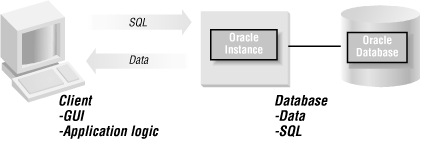Architectures for OLTP
Although all OLTP systems are oriented toward the same goals, there are several different underlying system architectures that you can use for the deployment of OLTP, including the traditional two-tier model, a three-tier model, and a model that encompasses the use of the Web.
Traditional Two-Tier Client/Server
The late 1980s saw the rise of two-tier client/server applications. In this configuration, PCs acted as clients accessing a separate database server over a network. The client ran both the GUI and the application logic, giving rise to the term fat clients. The database server processed SQL statements and returned the requested results back to the clients. While database servers were relatively simple to develop using visual tools, client/server systems were difficult to deploy and maintain as they required fairly high-bandwidth networks and the installation and regular upgrading of specific client software on every user’s PC.
Figure 8-1 illustrates the two-tier architecture.

Figure 8-1. Two-tier client/server architecture
Stored Procedures
Oracle7 introduced stored procedures written in PL/SQL, Oracle’s proprietary language for writing application logic. These procedures are stored in the database and executed by clients issuing remote procedure calls (RPCs) as opposed to executing SQL statements. Instead of issuing multiple SQL calls, occasionally ...
Get Oracle Essentials: Oracle9i, Oracle8i and Oracle8, Second Edition now with the O’Reilly learning platform.
O’Reilly members experience books, live events, courses curated by job role, and more from O’Reilly and nearly 200 top publishers.

